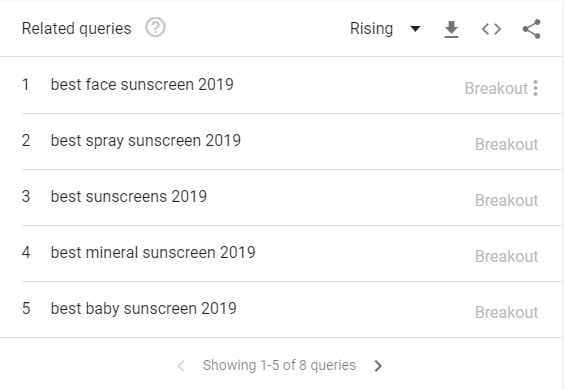If demographics are the “who” of content marketing, then intent is the “why.” While it’s important to know who your users are, it’s also important to know why they came to your website in the first place. Are they looking to buy, or are they just virtual window shopping? Are they researching out of personal interest, or out of professional obligation? Intent-based content marketing is a powerful framework for identifying (and acting on) the triggers that bring users to your website.
Neil Patel defines user intent as “the goal someone has in mind when they make a search.” In the early days of the internet, search engines were far less intuitive, and didn’t do the best job at picking up on user intent. Back then, a Google search for “Italian restaurant” would give you top ranked pages that contained the term “Italian restaurant” in their web content. Now, if you search “Italian restaurant,” Google assumes that you’re likely looking for restaurants in your area, which will be displayed first. This is a case of Google recognizing user intent.
The “what” and “why” of user intent
Intent-based content marketing allows you to go beyond demographics. For example, if you’re a company that makes baby bottles, your first instinct may be to target your content to new mothers, ages 20-30. Maybe you’d plan to write a series of blogs around advice for bottle feeding babies or compile a first-time mom FAQ. But, what about grandparents? Daycare owners? Foster parents? Single dads? The intent-based approach would be to target your content around people who are searching for “best baby bottles” or “how to bottle feed a baby”, rather than zeroing in on one demographic.
There are three forms of user intent:
- Informational
- Navigational
- Transactional
Informational intent
Informational intent essentially means that the user is looking for content as part of research, or because of their interests. They’re not looking to purchase as much as they’re looking to learn. So sales pitches will do nothing for them. The goal in this stage is to teach the user about your brand, and about how it’s relevant to their interests.
The content types this audience is looking for include:
- “How tos” and other educational content
- Entertaining “clickbait” articles
- Industry research
- Content that establishes your brand as a leader in your field
- Differentiating content that sets your brand apart
- Event coverage
Navigational intent
A user with navigational intent is looking for a specific resource. This could be a page on your website, a document they wish to download, or a video they want to view. They may also be looking to price and evaluate your service offerings or products against a competitor. In any case, they’re probably not interested in poking around your website looking for their desired resource. That’s why ease of navigation and a well-optimized user experience are key to helping navigational intent users successfully interact with your website.
The content types this audience is looking for include:
- FAQ pages
- Product manuals and warranty information
- Downloadable collateral content and guides
- Product listings and price comparisons
Transactional intent
Users with a transactional intent approach content with the purpose of completing a transaction. They’re convinced and ready to move down the sales funnel and convert. As nice as this sounds, less than 10 percent of users come to a website with transactional intent. That doesn’t mean you can’t help move users towards transactional intent, regardless of what their mindset was when they came to your website.
The content types this audience is looking for include:
- Product reviews, demonstrations, and success stories
- Case studies
- Product brochures and Q&A
- Competitor comparisons
- Promoted events
Predicting user intent
To “predict” user intent, you can strategize your content creation efforts around pre-intent. Pre-intent is the motivation before the lightbulb goes off and a user moves through the sales funnel. For example, say you’re creating content for a travel agency. A good first step you can try to capture pre-intent is to brainstorm what could spark a user to decide to book a vacation. Maybe they’re celebrating a major milestone, like a birthday, an anniversary, or a graduation. Or, maybe their tax refund just came in and they’ve got a bit more cash to burn. Creating content around these scenarios and seasonal events can help your brand stand out to users as they begin to search the web for these topics.
When it comes to predicting user intent, longtail keywords are what you’ll want to focus on. Longtail keywords can tell you a lot more about user intent than broad, one- or two-word search terms. It’s easier to make relevant, targeted content for a user who’s looking for “best at home dye for blonde hair” than “blonde hair dye.” You can assume this user is either looking to learn more about hair dye, or is looking to purchase a dye that best fits their specific hair.
While longtail keywords may have lower search volume, they allow you to narrow your focus to a specific subset of user intent. Plus, it can be easier to rank for longtail keywords than shorter keywords. You can learn more about longtail keywords and other SEO topics in our guide to What is Search Engine Optimization (SEO)?
Google Trends
Google Trends is useful for seeing how your audience is searching for topics that surround your brand, and identifying longtail keywords. For example, say you’re an organic sunscreen brand looking to expand content around sunscreen. Longtail keywords can be found in the “related queries” section. These show valuable opportunities for content that tailors to what users are searching for and looking to learn about.

The related queries for “sunscreen” reveal several insights. Users are looking for the best and safest sunscreen for their money. Circling back to user intent, let’s brainstorm why this may be. Of course, there’s the fact that this search was done during the summer. That means more trips to the pool, or outdoor adventures and travel. Parents may be buying sunscreen for the whole family, such as seeking special formulations for babies or kids with sensitive skin. Women may be looking for the best sunscreen to wear under their makeup. The list goes on, but the point is, even a simple one-word term like “sunscreen” can turn up endless user scenarios that you can use to your advantage.
Here’s how those scenarios can fit into the three types of user intent, in the context of your organic sunscreen brand.
Informational
What makes one sunscreen better than another? What’s the difference between organic, chemical, and physical sunscreens? Before making a purchase, users may be looking to educate themselves on the world of sunscreen.
Navigational
Perhaps a user already purchased your sunscreen and is looking for instructions on how to apply it. Or, they may be looking for an easy way to compare your products to a competitor. Either way, this user has navigational intent.
Transactional
If a user has a trip to the beach planned, they’re likely looking to check “sunscreen” off their packing list. With transactional intent, they’ll head straight for product pages and add the sunscreen they want to their cart.
Next steps
You may not be able to look into a crystal ball and predict a user’s next move, but understanding user intent is the next best thing. Optimizing your content marketing efforts around user intent allows you to move beyond the numbers, the graphs, and the bottom line and see your users for who they really are—complex people with thoughts, feelings, and motivations that brought them to your website.
